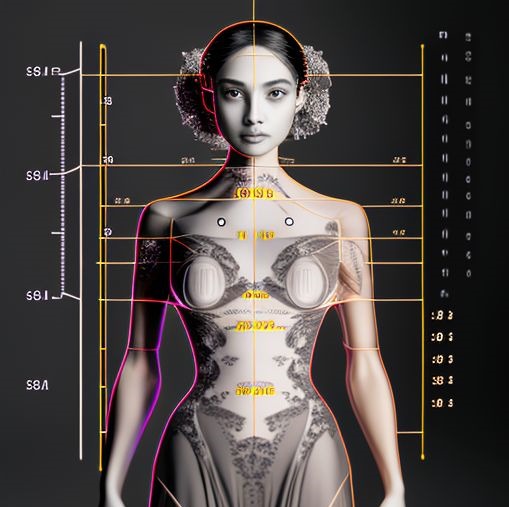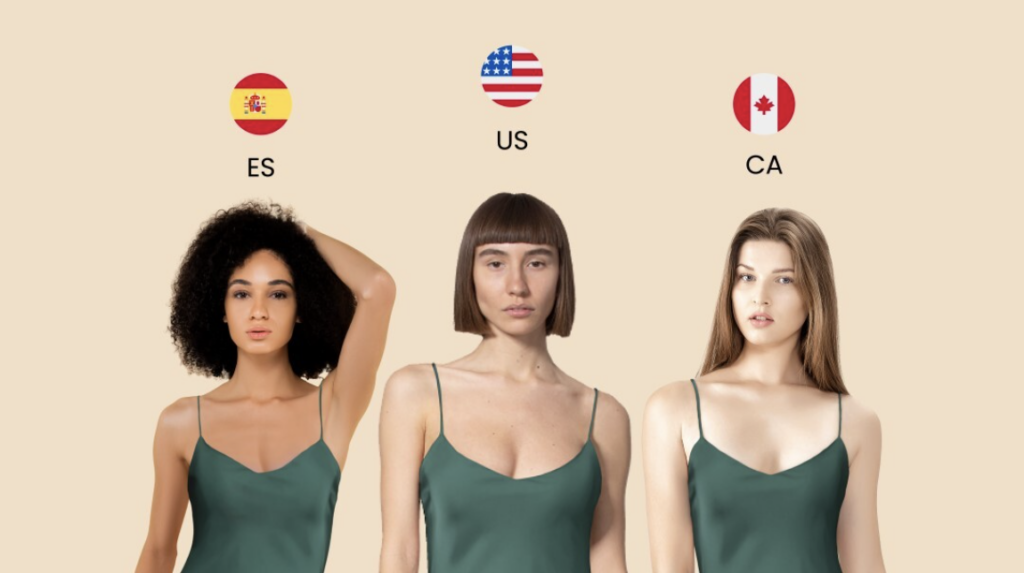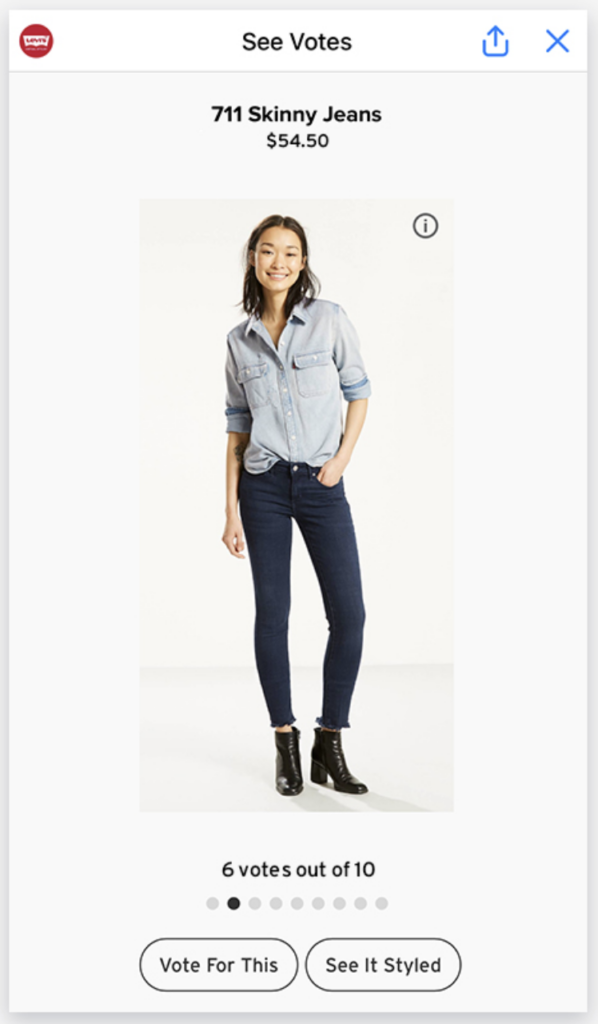The inconsistency of apparel sizing is not only a source of frustration for shoppers but also poses a significant challenge for fashion brands.
Interestingly, what was considered a size 16 dress in 1958 is now equivalent to a size eight dress. The practice of vanity sizing is partly to blame for this lack of standardization. Brands are reducing their sizes to make consumers feel more confident about their bodies and purchases without adhering to any standard sizing system.
Consequently, each brand bases its sizing on its perception of its target consumers, leading to significant variations in sizing. This lack of standardization is especially problematic for online shoppers, who cannot replicate the offline experience of trying on a product.
However, technological advancements in artificial intelligence and machine learning have brought about a combination of solutions to this problem.
The impact of AI and machine learning on the fashion industry
Fashion has come a long way since the days of sewing machines and hand-stitched garments. Nowadays, the fashion industry is a behemoth, with revenues expected to reach $2.25 trillion by 2025. Fashion may not be the first industry that comes to mind when we think about artificial intelligence. However, designers and brands that embrace the latest technology will be the ones to come out on top in the fast-changing world of fashion.

AI has revolutionized the fashion industry, enabling it to overcome some of the most vexing problems for consumers and online retailers, such as fashion sizing. It has been used to push the boundaries of design, manufacturing, and production, making it a game-changer in the industry. Below are six ways that AI and machine learning can address the challenge of ecommerce fashion sizing:
Personalization
Gone are the days of rummaging through racks of clothes, hoping to find the perfect size and style. The fashion industry is now gravitating towards a more customized strategy, with artificial intelligence (AI) leading the charge. The use of machine learning and advanced algorithms allows fashion brands to obtain a wealth of information about their customers. With this data, they can anticipate the preferences of their customers, when and how they desire it, and then respond appropriately. This approach saves time, guarantees an impeccable fit, and ultimately elevates the customer experience.
According to research conducted by Coresight Research and Sailthru for the 2022 Retail Personalization Index, 71% of consumers are more likely to shop frequently with brands or retailers that customize their communications. Although 98% of retail marketers utilize advanced personalization techniques, a significant number of them fail to provide personalized experiences that meet consumer expectations. It is vital for retailers to focus on developing customized experiences that offer genuine consumer engagement across multiple channels and facilitate the collection of zero- and first-party data to support personalized commerce in the future.
71% of consumers are more likely to shop frequently with brands or retailers that customize their communications, but most retailers fail to provide personalized experiences that meet consumer expectations
Fit Prediction
Fit Prediction is another game-changing application of AI in fashion. By analyzing customer feedback and returns, machine learning algorithms can determine the fit of different garments and make recommendations to customers based on their body shape and size. This means no more guesswork and a much higher likelihood of getting the perfect fit every time.
One example of a fashion retailer that uses fit prediction to analyze customer feedback and returns is Stitch Fix. The company leverages machine learning algorithms to determine the fit of various garments and makes personalized recommendations to customers based on their body shape and size. Stitch Fix collects data on each customer’s style preferences, body measurements, and feedback on previous purchases to make more accurate fit predictions. With this information, they can suggest clothing items that will fit well and flatter the customer’s body type, reducing the likelihood of returns and improving customer satisfaction. This approach not only benefits the customers but also allows Stitch Fix to optimize its inventory and minimize waste by producing garments that are more likely to fit customers well.
Generative AI
Generative AI takes personalization to a whole new level. It enables the creation of synthetic models that can be used to showcase outfits on different body types, skin tones, and more. This means fashion brands can showcase their products on an unlimited number of models, ensuring that everyone can find something that suits them.
Botika is a startups company developing synthetic models for the fashion industry . This approach helps retailers save a substantial amount of money that would have been spent on hiring real-life models, photographers, and studios. Moreover, it allows companies to showcase their products on a diverse range of body types and skin tones, appealing to a broader customer base from all over the world, while eliminating potential issues related to diversity and inclusion that could arise from using a limited number of real-life models. This innovative approach is a testament to the benefits of technology in the retail industry, providing cost-effective solutions while improving the customer experience.

Botika’s synthetic models created with generative AI
Virtual Try-On
Virtual Try-On systems represent the next phase of the digital evolution in size/fit prediction, aided by computer vision and 3D scanning. Although we haven’t fully achieved it yet, these systems will offer customers a precise depiction of how a piece of clothing will fit, minimizing return rates and guaranteeing customer contentment.
Online fashion retailers are increasingly incorporating virtual try-on features into their mobile apps, and ASOS, one of the world’s most renowned online fashion retailers, was among the first to do so, and today Walmart enables this feature on their website. The virtual try-on feature uses augmented reality technology to overlay the selected item onto the user’s body, creating a lifelike and immersive experience. This technology has the potential to further elevate the online shopping experience, reduce returns, and improve customer satisfaction.
Computer Vision
Computer Vision technology has enabled fashion brands to utilize 3D body scanning to assist customers in finding the appropriate size for their measurements. Levi Strauss & Co is a fashion retailer that uses this technology to offer a “Virtual Stylist” feature. Through computer vision and 3D body scanning technology, Levi’s Virtual Stylist creates a digital avatar of the customer’s body and suggests the most suitable fit and size for various Levi’s products based on the customer’s measurements and personal preferences.

Levi’s virtual stylist
Customers can receive personalized size suggestions for different clothing items with just a simple scan of their bodies using their phone cameras. The technology saves customers time and effort and helps reduce the number of returns, thus making online shopping a seamless experience for both customers and retailers. By providing customers with this technology, they are able to make more informed purchasing decisions and decrease the probability of returns due to sizing issues.
Digital Sizing
The use of AI in predicting customer sizes is rapidly becoming one of the most prominent ways technology benefits the fashion industry. This is because the traditional method of choosing a size based on a label can be inaccurate and often leads to customers returning their purchases due to incorrect sizing.
With AI, fashion brands can gather detailed information about a customer’s body measurements and purchase history to determine the size that is most likely to fit them perfectly. By utilizing machine learning algorithms, AI can also learn from customer feedback and adjust its predictions accordingly, making the process even more accurate over time.
This personalized approach benefits both the customers and the brands. For customers, it eliminates the hassle of returning items due to sizing issues, and ensures that they receive a product that fits well and meets their expectations. While for fashion brands, it reduces the costs associated with returns, improves customer satisfaction, and can even lead to increased sales and brand loyalty.
As we progress further into the digital age, we are witnessing an increasing number of innovative solutions that are powered by artificial intelligence and machine learning. Sizer is one such innovative solution that has emerged to help customers achieve the perfect fit when shopping for clothing online and improve the overall customer experience.
Final Thoughts
The fashion industry has been grappling with the challenge of inconsistent sizing for years, leading to frustration for shoppers and e-commerce retailers alike. However, technological advancements in AI and machine learning have brought about a solution to this problem. AI is revolutionizing how fashion brands approach sizing by enabling personalization, size prediction, fit prediction, generative AI, virtual try-on, and computer vision.
With the use of AI-powered tools, customers can now find the perfect fit for their body type, reducing the chances of returns and increasing customer satisfaction. As the fashion industry continues to evolve, embracing AI and machine learning will be critical for designers and brands looking to stay ahead of the competition and meet the needs of their customers.
Looking for an AI-powered sizing solution for your online store? Chat with a digital sizing expert today to learn more about how Sizer can help your business increase customer confidence, reduce returns, and boost sales. Request a demo today.
Blog posts in your inbox
Drop your email below

Thank you!
we’ll keep you updated




